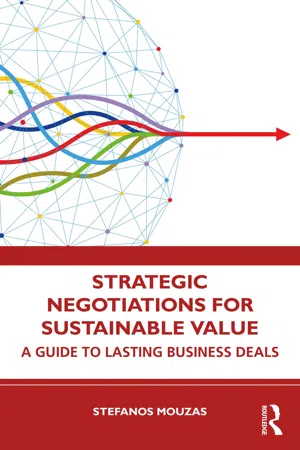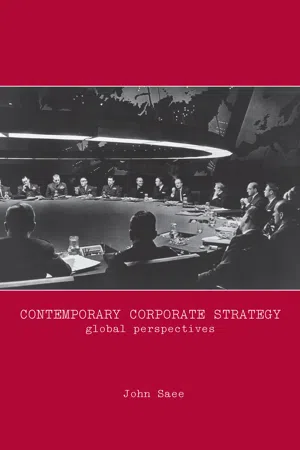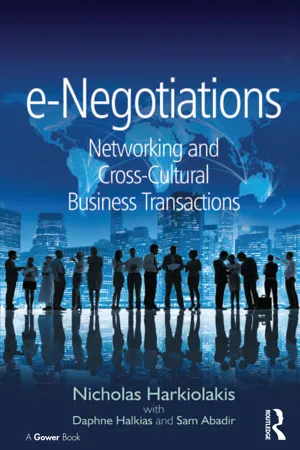Business
Negotiation Process
The negotiation process involves communication and bargaining between parties to reach a mutually beneficial agreement. It typically includes preparation, discussion, proposal, bargaining, and closure stages. Effective negotiation skills are essential for achieving favorable outcomes in business deals, partnerships, and contracts.
Written by Perlego with AI-assistance
Related key terms
Related key terms
1 of 4
Related key terms
1 of 3
8 Key excerpts on "Negotiation Process"
- eBook - ePub
The Fugitive Identity of Mediation
Negotiations, Shift Changes and Allusionary Action
- Debbie De Girolamo(Author)
- 2013(Publication Date)
- Routledge(Publisher)
5 The first step to a theoretical and practical understanding of mediation as it exists in the real world is to gain an insight into the structure of negotiation. Its structure is mediation’s processual shape, since it is the process by which negotiated order is achieved. To understand the Negotiation Process is to understand the process of the mediation, as mediation takes place within a negotiatory framework. It is within this conceptual framework of negotiation that mediation will be analysed in subsequent chapters. The intent is to highlight the nature of the interactions of parties at the mediation table – it will contextualize the interactions to illustrate the reality of the mediation process experienced by its participants.The study of negotiation offers the researcher a number of analytical frames through which to conduct an exploration. Theorists have approached negotiation as a series of strategic moves defined by the nature of the moves, as irrational human behaviour due to cognitive realities affecting decision-making or as a process of interactions.6 Arguably, negotiation is an amalgam of all three. Negotiation involves decision-making, interaction through communication between the decision-makers, norms and psychological factors impacting on the decision-makers, the resource desired or protected by the decision-makers and a little-known opponent faced by each of the decision-makers. In essence, negotiation is about joint decision-making involving parties in conflict who strive to communicate with an opponent within a normative and psychological context about a resource they want or do not wish to give up. The process involves social interaction. Cognitive influences inform the social interaction. Strategic moves occur within the process. Neither cognitive influences nor strategic moves alone, however, constitute negotiation. They are elements of a process that is - Mohammad Ayub Khan, Noam Ebner, Mohammad Ayub Khan, Noam Ebner, Mohammad Ayub Khan, Noam Ebner(Authors)
- 2018(Publication Date)
- Palgrave Macmillan(Publisher)
negotiation across cultures.No matter which professional activities you engage in in your daily life, learning about the art and science of negotiation will be useful for your success and growth. The human history is filled with examples illustrating the extent to which negotiation has always been present in human life, even if different names were used to describe the process. Differences associated with commercial transactions and conflict in interpersonal interactions have always been resolved in a harmonious and friendly manner through negotiation.The Concept and Scope
First, let us define the term “negotiation”. The term “negotiation” means discussion, bargaining , give and take , interaction, and dialogue. Furthermore, negotiation is a process where two or more parties with differences in opinions, interests, and objectives come together and try to reach an agreement through exploring options which are mutually acceptable and beneficial for them (Cellich & Jain, 2004 ). The term “negotiation” also refers to the process and system through which two or more parties, who are in a conflict situation over specific expected and unexpected outcomes, attempt to reach agreement through face-to-face dialogue. Negotiation is the constructive and positive alternative to haggling or arguing (including “formal argument” in the forms of adjudication and arbitration ), and it aims at building an environment for mutually acceptable agreement rather than searching for winning a battle (Pillutla & Nicholson, 2004 ). Other researchers in the field of negotiation define negotiation as an attempt by parties involved in the conflict to achieve a mutually acceptable outcome by clarifying and discussing issues; establishing the areas of controversy; clarifying positions taken and options for agreements; discovering and confirming areas of contracts; and explaining the terms of agreements and duties of the parties (Hartzell, 2006 ). Negotiation involves individuals, groups, organizations, and nations talking to each other directly (direct negotiation ) or through intermediaries (mediated negotiation) to find solutions to conflicting issues, to deal with transactions of mutual interests, or to address other human problems of diverse nature and scope (Kellecher & Wein, 2006- eBook - ePub
Strategic Negotiations for Sustainable Value
A Guide to Lasting Business Deals
- Stefanos Mouzas(Author)
- 2022(Publication Date)
- Routledge(Publisher)
ThreeDOI: 10.4324/9781003001010-3Negotiation as a processOverview of relevant themes- Negotiation as a process aiming at a jointly decided action
- Differences are the raw materials of the Negotiation Process
- ZOPA and BATNA
- Interests, issues, positions
- Five core concerns
- Value creation through wise trades
- Give-and-take process
- Giving in vs. demanding
Think about differences as a source of value. How is value created in strategic negotiations? What happens when we ignore the interests and the core concerns of our counterparts or when we treat them as adversaries. Price negotiations and ZOPA. Do you need to negotiate sequentially or simultaneously? Consider moves away from the negotiation table to create a favourable setup. Think about the role of options, e.g., BATNA in strategic negotiations. Think about balancing the process of giving in and demanding, and reflect on when to negotiate. What are the limits of negotiations and what is your personal experience when applying these concepts?3.1 The process of negotiation
What comes to our mind when we hear the word negotiation? Connotations and images connected with the word ‘negotiation’ may vary. Some might think about negotiations as endless discussions and arguments, others might think about negotiation as juxtaposition, competition and fighting. Not all of these connotations make negotiators feel comfortable. Hence, many managers, policymakers, lawyers, as well as groups of people and organisations remain sceptical and are rather reluctant to engage in negotiations. The intensity of negotiations, archaic images of ruthless fighting between negotiators or images of hagglers that bargain prices might prevent individuals and organisations from embracing negotiation. Yet, in an increasingly inter-connected business landscape, executives need to access the resources, skills and capabilities of other actors, both internally within their own organisations, as well as externally in the market. How should, then, individuals and organisations view negotiation? I have found that the best way to embrace negotiation is to view negotiation as a process. Thus, negotiation can be seen as a process - eBook - ePub
- Chimay Anumba, Zhaomin Ren, O.O. Ugwu(Authors)
- 2007(Publication Date)
- Routledge(Publisher)
Chapter 4 Negotiation theoriesZ. Ren, C. J. Anumba and O. O. Ugwu4.1 Introduction
Negotiation, as an important human co-operation approach, has been studied and defined by many researchers in different research domains, such as: economics, society, politics and AI systems. For example,- Collins Cobuild English Dictionary – negotiations are formal discussions between people who have different aims or intentions, especially in business or politics, during which they try to reach an agreement.
- Zartman (1977) – negotiation is a joint decision process between two or several parties or their representatives. Negotiation tends to be a matter of finding a formula encompassing the optimum combination of interests of both parties and then of working out the details that implement these principles and affect the agreement. Negotiation is a dynamic process, on-going, involving moves and countermoves.
- Hammer and Clay (1977) – negotiation is the interaction that occurs when two or more persons attempt to agree on a mutually acceptable outcome in a situation where their orders of preference for possible outcomes are negatively correlated.
- Gulliver (1979) – negotiation is one kind of problem-solving process, in which people attempt to reach a joint decision on matters of common concern in situations where they are in disagreement and conflict.
- Rosenschein and Zlotkin (1994) – negotiation is a form of decision-making process where two or more parties jointly search a space of possible solutions with the goal of reaching a consensus (deal).
- Lesser (1998) – negotiation, the process of arriving at a state that is mutually agreeable to a set of agents, is intimately related to co-ordination.
- From a social-psychological perspective, Bartos (1977) concludes that the nature of negotiation is to resolve the conflicts between competitive individualism and co-operative collectivism. Negotiation often involves dual and mostly conflicting motivations: the individual (competitive) desire to maximise one’s own utility and the collective (co-operative) desire to reach a fair solution. Negotiations can proceed smoothly only when they are guided by the collective desire for fairness or when the loss of breaking negotiation is higher than that of reaching an agreement for either party even if negotiators are selfishly motivated.
- Betty Jane Punnett(Author)
- 2018(Publication Date)
- Routledge(Publisher)
www.publishdonotperish.com accessed April 30, 2018). This is true whether you are at home or running a large multinational or transnational organization. Negotiating is complex anywhere, but it is one of the most important arenas of cross-cultural communication for international managers. Negotiations take place between investors and governments, potential business partners, buyers and sellers, employers and employees; in other words, negotiations permeate the international business world. Business will not take place unless negotiations are successful, yet, if the parties come to the negotiating table without understanding the barriers to, and complexities of, cross-cultural communication, there is a high probability that negotiations will not be successful. In this part of the chapter, we will look at the Negotiation Process and how it can differ from one location to another. It is important that negotiators try to understand the Negotiation Process from the point of view of the other party because this allows them to be more skillful and improves the likelihood that they will be able to conclude the negotiations and reach a deal that is beneficial for their organization.The Negotiation Process
The Negotiation Process has been described in terms of four stages: relationship building, exchange of task-related information, persuasion, and making concessions and agreements (Adler 1991). These stages occur in all negotiations. However, groups of people differ in terms of the value placed on each stage of the negotiation and the time spent on each one. In the following discussion, the Japanese and the Americans are used to illustrate how two groups may approach the same stage from very different perspectives.- eBook - ePub
- John Saee(Author)
- 2007(Publication Date)
- Routledge(Publisher)
Process is the single most important factor predicting the success or failure of a negotiation. An effective process includes managing the negotiation’s overall strategy or approach, its stages and the specific tactics used. As with other aspects of negotiating, process varies markedly across cultures. An effective strategy reflects the situational characteristics and personal backgrounds of the negotiators involved. It balances the position, procedure, timing and roles of the negotiating partners (2).To successfully negotiate globally, Fisher and Ury (1981) advocate for a culturally synergistic approach, based on a principled negotiation method, which could lead to fruitful cross-cultural negotiations. This approach involves four steps:1 separating the people from the problem; 2 focusing on interests, not on positions; 3 insisting on objective criteria (and never yielding to pressure); and 4 inventing options for mutual gain.Principled negotiation provides participants to the negotiation with a method of focusing on the basic interests and the mutually advantageous solutions. It enables parties to reach agreement without haggling and posturing (8).Stages of a negotiation
There are several basic steps involved in managing the Negotiation Process. The first phase typically begins with planning.Planning
Planning starts with negotiators identifying those objectives they would like to attain. Next, consideration is given to areas of common ground between the parties. Other major areas include: - eBook - ePub
e-Negotiations
Networking and Cross-Cultural Business Transactions
- Nicholas Harkiolakis, Daphne Halkias(Authors)
- 2016(Publication Date)
- Routledge(Publisher)
Negotiators are rarely on their own when working on a deal: they are usually part of or representatives of organizations with some kind of hierarchical structure. This implies that they are accountable to someone in the organization that acts as a supervisor or evaluator. This in itself is enough to create some kind of performance anxiety that negotiators should be aware of. Organizational politics might be very influential whether the negotiator is aware of it or not. Many times there is a bigger “game” being played and the negotiation that’s taking place might just be a strategic move with completely different objectives than the negotiation itself. It might be that the negotiation is just an intimidation tool for something else that the management is working on that might not even involve the party we are negotiating with. This makes it extremely difficult for the negotiator unless they have inside knowledge of what is going on.In case we don’t know or cannot imagine the game being played, but we suspect something might be going on, the best approach is to just act as professional as possible without sacrificing personal connections that we might have committed to the process. Feeling like a pawn can be very uncomfortable and a threat to someone’s personality, but the truth of the matter is that businesses rarely act in good faith and good intention. We shouldn’t forget that the very essence of competition in the business world is survival of the “fittest” and elimination of the “weakest.” Executives need to back up their vision of a negotiation with actions that have an impact at the negotiating table.5.4 Strategic Process and Guidelines
While process moves do not directly concern the negotiation issue, they directly affect the way these issues will be heard and perceived and thus influence outcome. Some general tips for handling the Negotiation Process are summarized here.I. PREPARE THE AGENDA
Negotiations actually begin from the moment any one of the parties starts manipulating the process, long before the various parties come together physically or online. For example, organizing the agenda and the way people will be heard and ideas presented can exert strong influence and affect the receptivity of the proposal we want to promote.Although manipulating the agenda to one’s benefit might sound Machiavellian, it is a standard practice in the world of business (and politics of course) and negotiators should master the skill early enough in their career. Negotiators can engineer the agenda so as to frame the subsequent discussion to support their proposal before positions become fixed in the opponent’s mind.II. PRE-NEGOTIATIONS PHASE
A good step in the direction of subliminally influencing the negotiation is to plan seed ideas early. Sometimes parties might ignore certain comments, or even people, for whatever the reason might be. Being ignored doesn’t have to be a relationship of our low participation or strength of negotiating. It could also be that your opponents were caught off-guard and their behavior is just a defence mechanism. Negotiators, like most people anyway, tend to reduce their attention span whenever something looks or sounds familiar. - eBook - ePub
- Michael Roloff(Author)
- 2012(Publication Date)
- Routledge(Publisher)
In intracultural negotiation, the process of negotiating may be comparatively easy, because culture does not breed miscommunication. However, agreement may be more difficult to reach because of competing goals. In intercultural negotiation, process becomes more difficult, because culture creates communication barriers. However, a satisfying outcome is more likely due to differing cultural emphases and issue utilities. This theory ignores the important relationship between Negotiation Processes and outcomes. In any context suffering from miscommunication, barriers to the process of negotiation may have dire consequences for the final outcome. However, the theory does begin to explain the lack of consistent results across intra- and intercultural negotiations (e.g., Adler & Graham, 1989; Francis, 1991). This is consistent with Bonham’s (1993) notion that culture’s effects are found in the ways that culture affects the perceptions and interpretations of negotiators. He theorizes that cognitive maps can help represent negotiators’ substantive knowledge of an issue as well as negotiators’ assumptions and goals regarding process. Finally, Weiss (1993) presents a return to modeling as a theoretical perspective. The RBC model represents links among the three basic components of international business negotiations across relevant levels (i.e., interpersonal, interorganizational, and intraorganizational). The R refers to “relationships,” symmetric or asymmetric connections between negotiators, members of a negotiation team, or organizations who negotiate through agents. Encompassed in the relationship category are common interests, power, trust, and perceptions. B refers to “behaviors,” actions directed toward or affecting another party. Included in this category are perceptions, information processing, judgment and decision making, planning, verbal styles, concession making, integrativeness, and proposals
Index pages curate the most relevant extracts from our library of academic textbooks. They’ve been created using an in-house natural language model (NLM), each adding context and meaning to key research topics.
Explore more topic indexes
Explore more topic indexes
1 of 6
Explore more topic indexes
1 of 4







